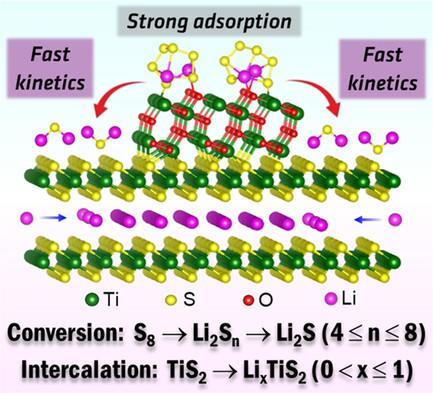Intercalation‐Conversion Hybrid Cathode Enabled by MXene‐Driven TiO2/TiS2 Heterostructure for High‐Energy‐Density Li–S Battery
引用次数: 0
Abstract
A dense electrode with high sulfur loading is a straightforward approach to increasing the energy density of lithium–sulfur battery (LSB), but the development of dense electrodes suffers from both fabrication challenges and electron/ion transport limitations. In addition, the shuttle effect of soluble lithium polysulfides and sluggish reaction kinetics cause declined utilization efficiency of the active material and poor cycling stability. Herein, a dense intercalation‐conversion hybrid cathode is prepared using MXene‐driven TiS2 nano‐needles decorated with TiO2 nanoparticles. The TiO2/TiS2 heterostructure simultaneously possessing a high adsorption capability (TiO2) and bidirectional electrocatalytic effect (TiS2) is observed to effectively suppress lithium polysulfide shuttling and facilitate the sulfur conversion reactions. Furthermore, it is believed that TiS2 provides additional capacity from the intercalation reaction and functions as a multichannel network to feed both Li+/e− to the active sulfur material due to its high electronic and ionic conductivities. Thanks to these synergistic effects, the LSB assembled using the TiO2/TiS2 heterostructure exhibits high gravimetric and volumetric energy densities of 331 Wh kg−1 and 730 Wh L−1, respectively, as well as superior cyclability at a high sulfur mass loading of 7.5 mg cm−2 and lean electrolyte of 2.5 μL mg−1.

利用 MXene 驱动的 TiO2/TiS2 异质结构实现互钙-转换混合负极,用于高能量密度锂离子电池
高硫含量的致密电极是提高锂硫电池(LSB)能量密度的直接方法,但致密电极的开发面临制造挑战和电子/离子传输限制。此外,可溶性多硫化锂的穿梭效应和缓慢的反应动力学也会导致活性材料的利用效率下降和循环稳定性变差。在此,我们利用装饰有 TiO2 纳米颗粒的 MXene 驱动型 TiS2 纳米针头制备了一种致密插层-转换混合正极。据观察,TiO2/TiS2 异质结构同时具有高吸附能力(TiO2)和双向电催化作用(TiS2),能有效抑制多硫化锂的穿梭,促进硫转化反应。此外,由于 TiS2 具有较高的电子和离子电导率,它还能从插层反应中提供额外的容量,并作为多通道网络将 Li+/e- 馈入活性硫材料。得益于这些协同效应,使用 TiO2/TiS2 异质结构组装的 LSB 在 7.5 mg cm-2 的高硫质量负载和 2.5 μL mg-1 的贫电解质条件下,分别表现出 331 Wh kg-1 和 730 Wh L-1 的高重力和体积能量密度,以及卓越的可循环性。
本文章由计算机程序翻译,如有差异,请以英文原文为准。
求助全文
约1分钟内获得全文
求助全文

 求助内容:
求助内容: 应助结果提醒方式:
应助结果提醒方式:


